A succulent is any plant with thick, fleshy (succulent) water storage organs. Succulents store water in their leaves, stems, or roots. Succulent plants are some of the hardiest, most drought tolerant in the world and very easy to maintain, as long as they are planted in a porous soil, proper drainage, daily bright light, and not over watered.
Succulent plants may be herbaceous or woody, most are perennial, coming back every year, and some may be monocarpic and thus die after flowering. Succulents range in their habits and hardiness ratings, most are tender and won’t cope with freezing temperatures, but there are also many hardy succulents which can.
List of Succulents With Yellow Flowers
- Lithops (Living pebble)
- Sedum acre
- Aloe Vera
- Eastern Prickly Pear Cactus
- Echeveria lutea
- Aeonium Kiwi
- Baby toes plant
- Little pickles
- Bergeranthus concavus
- Rebutia krainziana
- The Tiger’s Jaw
- Tree of Love
- Irish Rose
- Yellow Pig’s Ear (Cotyledon orbiculata)
- Pink Jelly Beans
- xCremnosedum little gem
- Aeonium simsii
- Senecio tamoides
- Senecio inornatus
- Delosperma nubigenum (Hardy Yellow Ice Plant)
Lithops
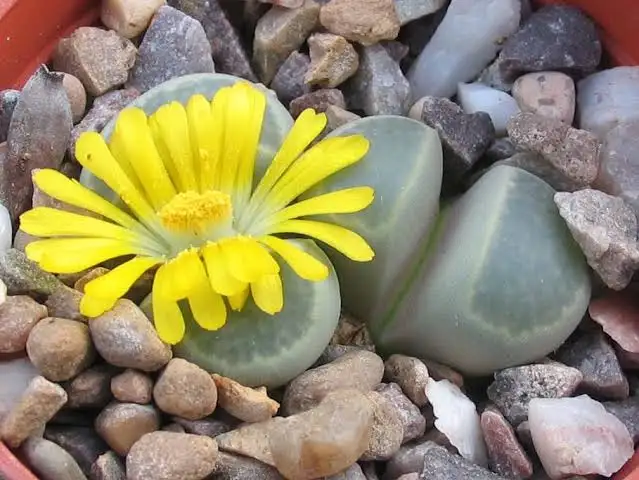
Lithops plants consist of two bulbous fused leaves with a slit in the middle and produce leaves in the spring and yellow or white daisy-like flowers in the late summer and autumn. There are at least 37 species and more than 145 varieties of Lithops, which all have a similar shape but feature various color combinations of gray, brown, rust, green, and pink. These plants also have markings such as curved lines and dots, which give certain Lithops the appearance of two hemispheres of a brain.
Sedum acre
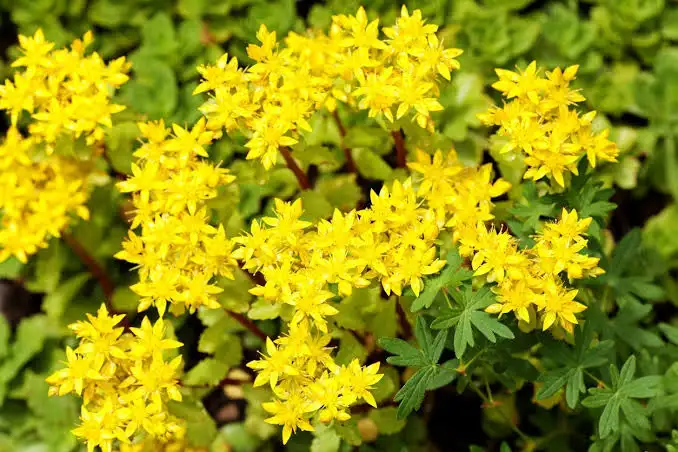
Sedum acre, commonly known as the goldmoss stonecrop, mossy stonecrop is a tufted evergreen perennial that forms mat-like stands some 5 to 12 cm tall. For much of the year the stems are short, semi-prostrate and densely clad in leaves. At the flowering time, the stems lengthen and are erect, somewhat limp and often pinkish-brown with the leaves further apart.
The leaves are alternate, fleshy and shortly cylindrical with a rounded tip. They are also sometimes tinged with red. The starry flowers form a three to six-flowered cyme. The calyx has five fleshy sepals fused at the base, the corolla consists of five regular bright yellow petals, there are ten stamens, a separate gynoecium and five pistils.
Aloe vera

Aloe vera is a succulent plant species of the genus Aloe. The plant is stemless or very short-stemmed with thick, greenish, fleshy leaves that fan out from the plant’s central stem. The margin of the leaf is serrated with small teeth. The flowers are produced in summer on a spike up to 90 cm (35 in) tall, each flower being pendulous, with a yellow tubular corolla 2–3 cm long.
Also Read: Different Types of Echeveria Plants
Eastern prickly pear
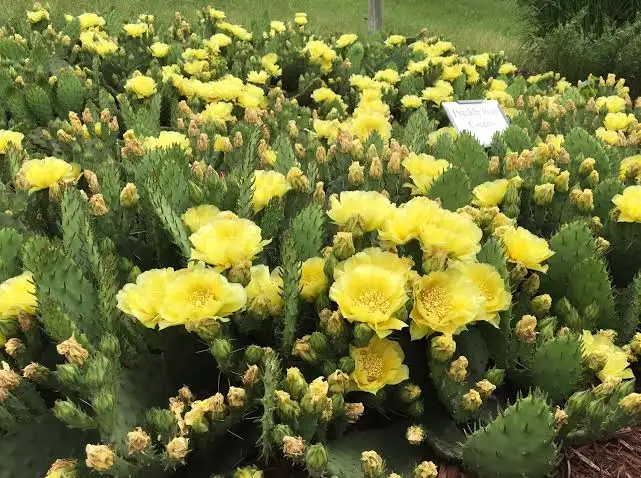
Opuntia humifusa, commonly known as the devil’s-tongue, Eastern prickly pear or Indian fig, is a perennial succulent cactus with jointed, rounded, but flattened, green stems, the segments of which are called “pads”. It may be horizontal or upright, growing up to 0.5 metres in height. Typical of most cacti, the pads are armed with barbed bristles and spines.
Yellow, waxy flowers about two to three centimetres in diameter, with centres, bloom along the edges of the pads. The juicy, edible fruits are green, ripening to reddish-brown. The Eastern Prickly-pear Cactus grows in dry sandy areas that are relatively open and sunny.
Echeveria lutea
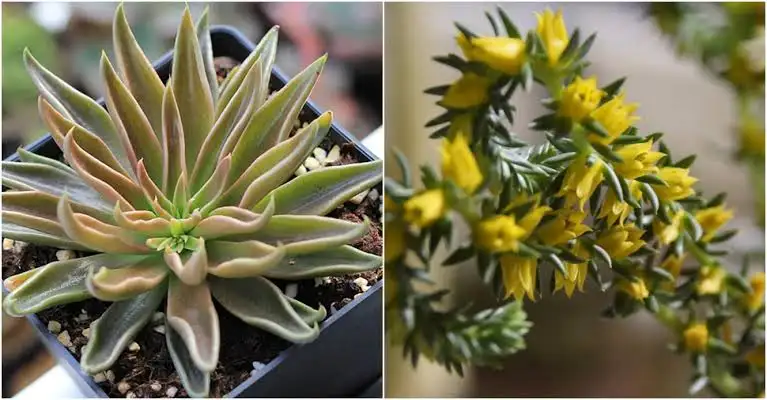
Echeveria lutea is a succulent that is also called Yellow Echeveria is small in size and form rosettes that are solitary in nature. The leaves are mostly red and purple in color and the rosette can grow up to a height of 8 inches in diameter.
The leaves have a distinct style as they roll by the margin while growing upwards, which creates a small hollow space in between. The unbranched flower inflorescence appears during summer and rises well above the foliage on a straight stalk and arches over towards the tip so that the clear yellow flowers point downwards.
Aeonium kiwi

Aeonium kiwi is a sub-shrub, meaning it only produces woody growth near the base and doesn’t get very tall. These succulents typically only reach about 2’ – 3’ feet with an equal spread. The plant produces multiple rosettes, each measuring about 3” – 5” inches. The spoon-shaped leaves appear dark green near the base and lighter near the top with the upper leaves achieving a kiwi-colored appearance.
The edges of the upper leaves at times have a reddish or purplish color. The kiwi Aeonium, doesn’t follow the same growth cycle as most succulents. These plants display yellow flowers in the summer. They appear in clusters and don’t produce a noticeable scent.
Baby toes plant
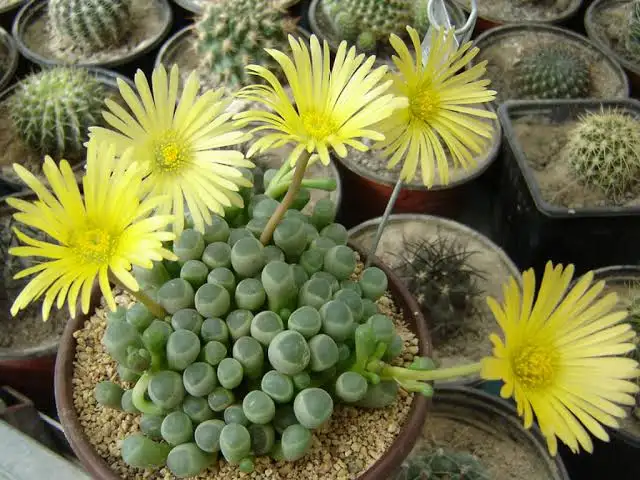
The baby toes plant is characterized by small transparent windows along the top of the leaves that have a waxy finish to them. These leaves allow light to pass through them and give a very appealing look to the plant. The roots of this plant are thick with little to no stem.
The daisy-like flowers bloom from late summer to early spring with flowers growing in bunches of twos or threes. They are either white or yellow in color and, generally, do not have any fragrance. Fenestraria is not a very tall plant. The finger-like leaves grow in upright clusters reaching up 3” to 6”. In case it has a stem, it is usually very small.
Also Read: Succulents With Purple Flowers
Delosperma nubigenum

Delosperma nubigenum (Hardy Yellow Ice Plant) is a mat-forming, evergreen succulent with bright yellow, daisy-like flowers. Blooming continuously from late spring to fall, the blossoms are produced in such quantities that they literally cover the foliage of closely-packed, fleshy green leaves.
The foliage turns bronze in winter. The intensity of the flower color, combined with the long blooming season and evergreen foliage, reinforce the ornamental interest of this plant. Perfect choice as a groundcover or for rock gardens.
Little pickles
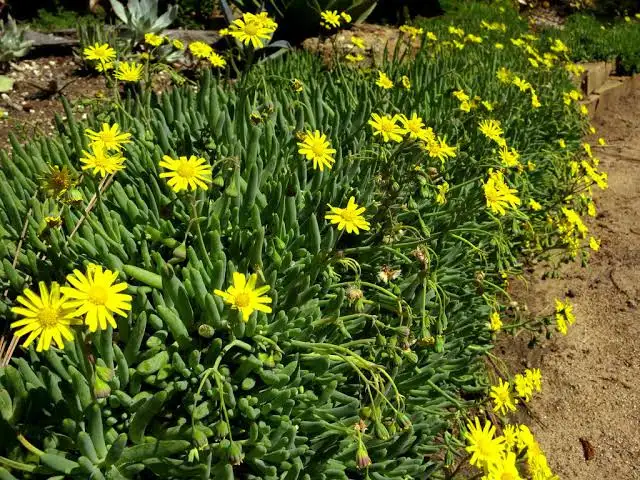
Crassothonna capensis, also known as little pickles or ruby necklace, this trailing succulent has brilliant purple to rich, ruby red stems with lush green leaves. Under healthy sun stress, the leaves take on the purple and red coloration of the stems. Ruby Necklace blooms often and the bright yellow flowers are a bright contrast to the jewel-toned foliage.
Bergeranthus concavus
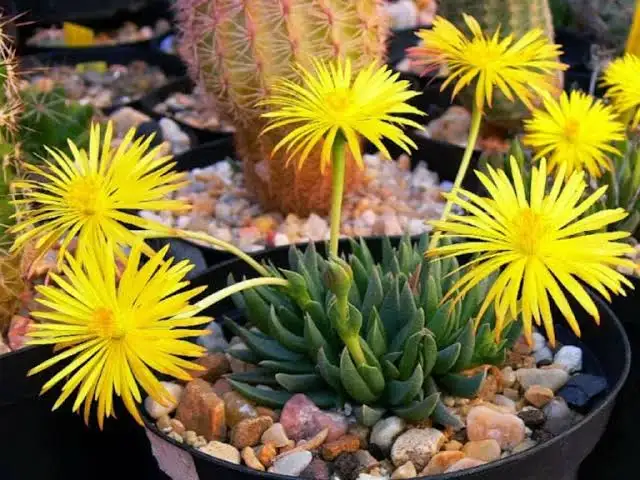
Bergeranthus concavus is a small tufted succulent with upright, succulent leaves ending in distinct awns. Flowers yellow. The specific name refers to the concavity of the ovary’s upper surface. Bergeranthus are easy and rewarding plants than can be grown in pots or in the rock-garden.
They can be watered year-round, water regularly from spring to Autumn but reduce watering frequency in winter, growth period is early Spring to late Summer, but is a very adaptable species that can grows opportunistically whenever the water availability and growing condition are.
Rebutia krainziana

Rebutia krainziana is a small and globular small cactus.
The dark green stem is solitary at first, after three or four years rounded offsets emerge in a ring around the base of the primary stem to form a compact cluster.
Rebutia krainziana cluster can reach size up to 15 cm. White and small areoles stand out on the stem. The areoles are covered of white spines: tiny, short and soft. In spring blooms the large red flower, funnel shaped, with grows from the base of the stems. Sometimes the flower can be orange or yellow or white (very rarely).
Cremnosedum ‘Little Gem’

Cremnosedum ‘Little Gem’ forms dense mats of tiny rosettes with fleshy pointed leaves. Leaves are olive green but develop a rosy blush in full sun. In late winter to early spring, they produce pretty clusters of starry yellow flowers.
These succulents need bright light and well-draining soil. Place indoor plants near a southern or western window but not so close to the glass that they will sunburn. Outdoors, plant in pots around the patio or in the ground around pavers, border edges, and even in rockeries.
Also Read: Different Types of Succulents For Your Home
Tiger jaws
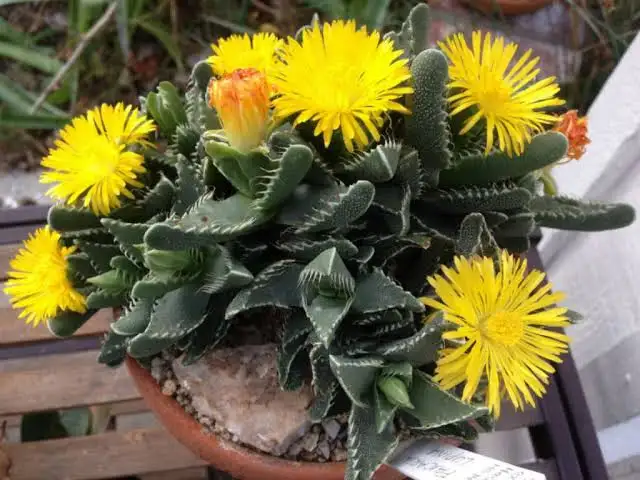
Tiger jaws is a dependable, slow-growing succulent plant with low rosettes of fleshy, triangular leaves edged with spiny “teeth.” The teeth are evolutionary adaptations designed to help the plant direct rainwater and dew down the base of the plant, where it can be absorbed by the roots.
“Tiger jaws” and an alternate common name, “shark jaws,” derive from the fierce look these soft spikes give the plant. In reality, the spikes are quite soft and flexible to the touch. The Tiger jaws displays bright yellow arching long slim petals. These bloom from fall – early winter and require at least 3 hours or more direct sun to bloom. Flowers will open up around midday then close up before the evening.
Tree of Love
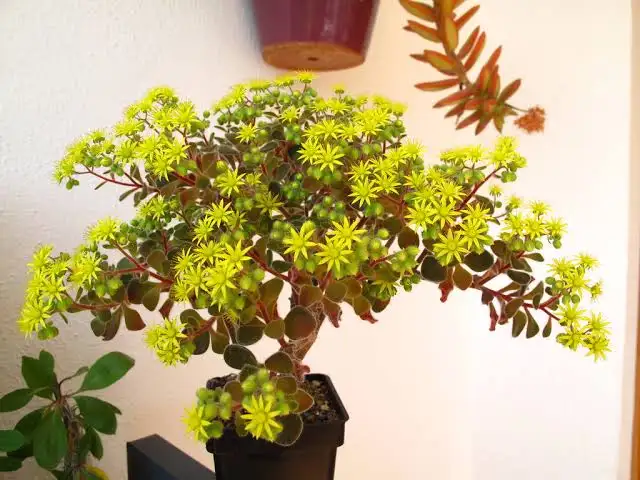
Aichryson Laxum, or Tree of Love, as it is otherwise called, is an indoor plant, popular for its unique appearance and for being easy to grow, even by novice growers. The plant received the name “Tree of Love” thanks to its leaves that have a heart-shaped form. The plant rarely grows more than 30 cm in height with erect stems with numerous thin branches.
The leaves are large, shaped like a spoon, dark green in color. They are assembled into sockets at the ends of branches. Petioles short. The color of the leaves depends on the light. In the bright sun they become brownish-green or khaki. Tree of Love blooms in spring and lasts up to six months. After flowering, the plant may die. The pale yellow flowers with 13-6 mm in diameter are collected in the inflorescence, which appear from the center of the rosette of leaves.
Irish Rose

Irish Rose is a succulent but is almost tiny tree-like in its appearance. Growing a long woody stalk like trunk gives this plant some height growing up to 3′ tall. It has a lime green to dark green appearance and grows a pyramidal stock from the center of the leaves that will bloom yellow star-like small flowers in spring. These are not a tight growing plant but rather longer leaves at 2-3″” each with an almost spoon-shaped appearance.
Cotyledon orbiculata
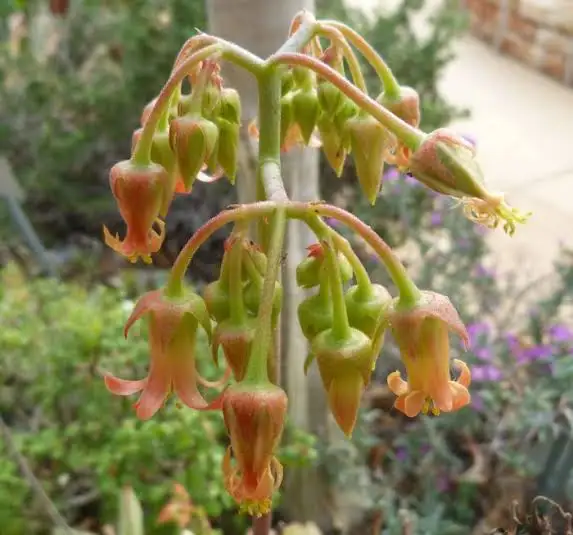
This succulent plant has thick leaves which may vary from green to grey, often with a red line around the margin. Cotyledon orbiculata has five varieties, based on differences in leaf and flower shape. The variability of leaf size, shape and colour is also influenced by the immediate environment. Selected forms in cultivation have been given names such as Elk Horns or Silver Waves.
Flowering time is mostly in winter from June-August, but in the winter rainfall areas such as the Western Cape, it is often in midsummer. The colourful, hanging, tubular/bell-shaped flowers are carried in clusters on the ends of an elongated flower stalk. They are mostly orange-red , but yellow flowering forms are also occasionally found.
Also Read: Different Types of Haworthia Plants
Pink Jelly Beans

Sedum x Rubrotinctum ‘Aurora’, commonly known as Pink Jelly Beans is a herbaceous perennial with succulent jelly-bean like leaves. The small leaves are green with red-brown tips and often develop bronze tones during summer. It typically grows to 20 cm tall and the same wide. Performing well when grown in full sun on well-drained soil. It is tolerant of extended dry periods, light frost and some shade.
Over time, Jelly Bean will form prolific clumps and the stems will become long enough to sprawl and gently cascade from containers. In spring, it produces clusters of tiny, star-shaped yellow flowers that attract pollinators. This variety is one of the easiest to propagate and it will readily grow roots from both stem cuttings and leaves.
Aeonium simsii
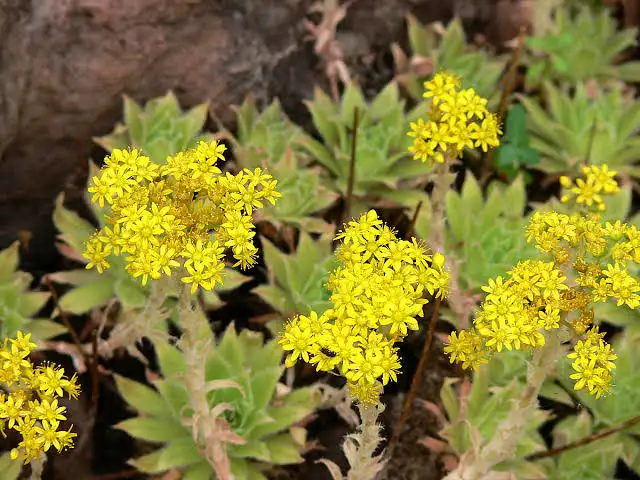
The Aeonium simsii has several branches that form a large cluster or bush of leaf rosettes. Each rosette measures up to 5 inches in height. The leaves are usually bright green in color, marked by small darker green stripes on the surface. The leaves are sticky and have small white teeth on their boundaries and a sharp tip. In terms of size, the external leaves appear slightly bigger but are quite small. The flowers bloom in clusters in the spring months. They are yellow in color.
Senecio inornatus
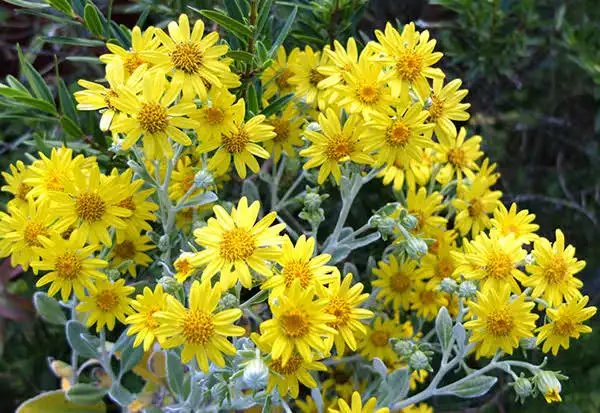
Senecio inornatus is a robust perennial herb with one or more stems from an underground rootstock, reaching up to 2m high. Plants are usually hairless but can also be covered by a white cobwebby woolly layer. Most of the leaves are basal and diminishing in size upwards along the stem, generally sessile and narrowing to both ends. The leaf blade often extends somewhat along the stem at the base. Leaf margins are dentate, but usually only have small wart-like outgrowths along margins.
These solitary plants are often much taller than the surrounding grass and in moist areas large numbers of plants often dominate the landscape; their bright yellow flowers and honey-like scent attracting many insects.
Senecio tamoides
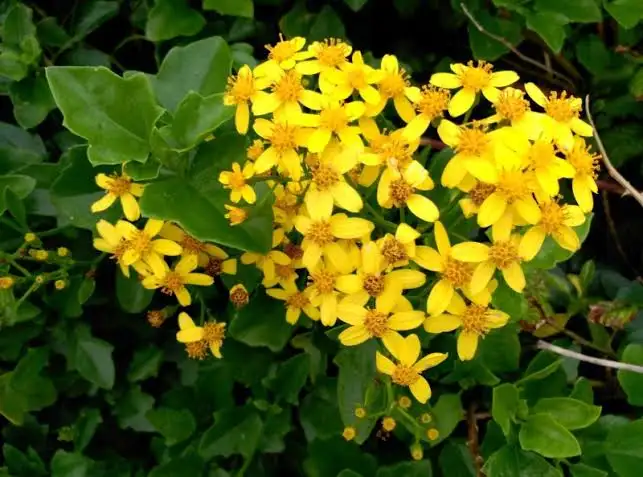
A vigorous fast-growing climber with semi-succulent stems and leaves. It is mostly evergreen, but during severe winters or in areas that suffer from frost, it will react deciduously, dying back and then recovering beautifully again in the spring.
The light green, shiny, fleshy leaves resemble those of ivy in that they are roughly triangle-shaped with unequal lobes and are attractive all year round. The wonderfully bright canary yellow daisy flowers are borne massed in clusters during late summer and autumn (March to July), making a lovely show; they also have a delightful aromatic scent. The seeds are typical of the daisy family — fluffy and creamy white.